
Étienne-Jules Marey (1830 - 1904)
During the 1860s Marey threw himself into the study of flight, first of insects and then birds. His aim was to understand how a wing interacted with the air to cause the animal to move. He also devised some ingenious apparatus based on his graphical method, such as a corset which allowed a bird to fly around a circular track while recording the movements of its thorax and wings.
Marey discovered that the insect's wing described a double ellipse (a 'figure 8') in the space of one revolution. Some years later, chronophotography confirmed that the same was true of the wing of a bird. In his lectures at the Collège de France, where he taught from 1867 onwards, Marey presented drawings and graphics to illustrate his theories, and demonstrated machines reproducing the flight of the insect and the trajectory of its wings. Any aeronauts in the audience must have been fascinated to see these machines in operation, no doubt feeling that they were now very close to their goal. At this period, French aviation was in a state of continuous development, with numerous flying machines being constructed and perfected. These included dirigible airships, machines with flapping wings, helicopters, and balloons with wings.
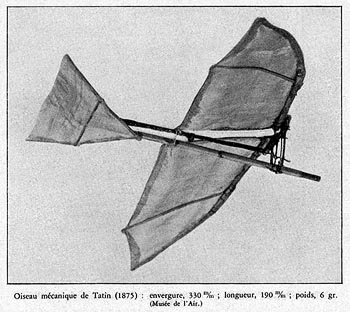 Victor Tatin, Ornithopter, 1875
Yet aviation as we know it was still in a state of limbo, since advocates of the heavier-than-air aeroplane were seen as cranks. However Alphonse Pénaud, a member of the Société de Navigation Aérienne ("Aerial Navigation Society") presided over by Hureau de Villeneuve, remained convinced that human flight would only be possible by means of the aeroplane. He had identified the problems which had to be solved in order to build the machine of his dreams: the resistance of the air, that of the materials used, and above all the essential need for a lightweight engine. He had foreseen everything that would make the flight of aeroplanes possible, but failed in the application of his theories and finally committed suicide.
 Victor Tatin compressed air powered Aeroplane of 1879 Download a 1500pixel image
Marey was no stranger to the first faltering steps of aviation. He was aware of all the work, followed Pénaud's research, wrote articles for Hureau de Villeneuve's journal L'Aéronaute, and even became vice-president of the Société de Navigation Aérienne in 1874. Aware that "the most perfect examples of locomotion which man has achieved are in general obtained by methods quite different from those of nature," Marey supported the work of his friend Victor Tatin, whose aim was to construct, not a balloon or a machine imitating the flight of an insect or bird, but a true aeroplane. He placed the laboratories and grounds of the Station Physiologique at the aeronaut's disposal, and in 1879 Tatin achieved his goal. Through Marey's advice and his own lengthy research and talents as a craftsman, the device which he designed, one of the very earliest aeroplanes, completed a flight around the track of the Station at a speed of eight metres per second.
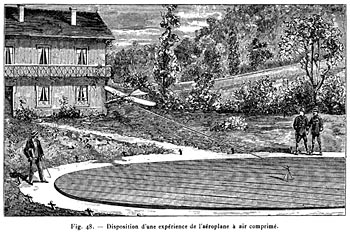 Victor Tatin aeroplane flying around the track at Chalais-Meudon Aéroplanes, "Navigation aérienne, appareils plus lourds que l'air", La Nature, 25 October, 1884 Download a 1500pixel image
After this first success Marey continued to support the pioneers of aviation. He published Le Vol des Oiseaux (The Flight of Birds) in 1890, and presented the work of Clément Ader, a famous aviation pioneer, at the Académie des Sciences in 1898. Finally he turned his attention to aerodynamics. His research in this area included the construction of a smoke machine which helped him to understand "how the air behaves as it provides support to the wing". Marey therefore made a considerable contribution to one of the great discoveries of his time. But he died too soon to see true aviation, or to see that another of his inventions, medical in its nature, would find use in aircraft (where it is still used today). This was his "investigative drum", whose principle was to be used in the design of manometric pressure-measuring capsules. Further Reading Étienne-Jules Marey. Physiologie du Movement. Le Vol des Oiseaux. Paris: G. Masson, 1890. 8vo., xvi, 394 pp., 1 photographic plate and 164 illustrations in the text. Braun, Marta. Picturing Time: The work of Étienne-Jules Marey (1830-1904). Chicago: The University of Chicago Press, 1992. 4to., xx, 450 pp., 184 b&w plates from photographs, drawings, etc.
Étienne-Jules Marey's 'machine for imitating insect flight' Early in 1869 Marey constructed a very delicate machine to demonstrate the flight of an insect and the figure-8 shape it produced during its movement. His artificial insect, with a body formed by a drum containing compressed air, could move up, down, and even diagonally.
 Étienne-Jules Marey's "insect flight machine" Watercolour by E Valton, 1869
"A mechanism actuated by an air pump produces alternate raising and lowering of a pair of wings constructed to the same design as those of the insects, formed, that is to say, with a rigid framework to the front and a flexible surface behind, made of rubber supported by thin steel shafts ... the small model which I present to the Académie [des Sciences, on 15 March 1869] develops a tractive force which may be measured by the dynamometer and which represents the raising of a weight of eight to ten grams. ... If the tip of one of the wings of this artificial insect is gilded, we see that all the movements and changes of shape in the flight of the real insect are reproduced in the mechanical apparatus."
Articles from Harper's New Monthly and Scientific American 1869 - 1871 relating to Marey's experiments
 The Velocity of Insects' Wings during Flight
Scientific American, New Series http://cdl.library.cornell.edu Download a 500pixel image
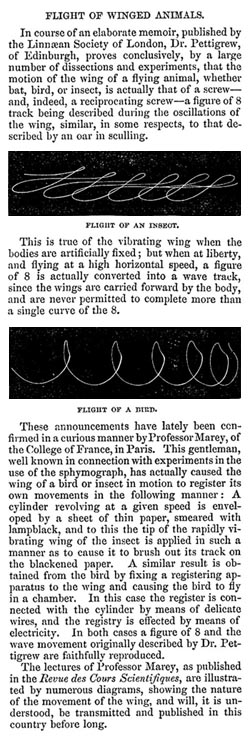 Flight of Winged Animals
Editor's Scientific Record, Harper's New Monthly magazine http://cdl.library.cornell.edu Download a 500pixel image
 Flight of Birds and Insects
Editor's Scientific Record, Harper's New Monthly magazine http://cdl.library.cornell.edu Download a 500pixel image
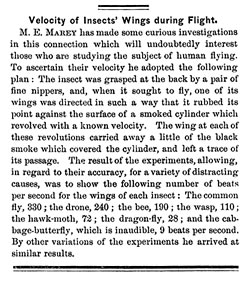 Velocity of Insects' Wings during Flight
Manufacturer and builder http://cdl.library.cornell.edu Download a 500pixel image
 Marey's Apparatus for Recording the Flight of Birds
Editor's Scientific Record, Harper's New Monthly magazine http://cdl.library.cornell.edu Download a 500pixel image
Étienne-Jules Marey's 'bird in the ring' The bird on its circular measuring track was fitted with a small corset and carried a small piece of wood on its back, to which was attached an instrument later known as the "air pantographe". This consisted of two rubber capsules mounted on a universal joint, connected to a long rod touching the bird's wing joints.
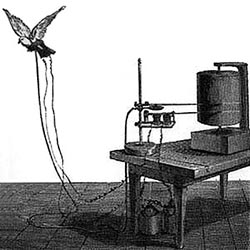 Étienne-Jules Marey's "air pantographe" Marey, Étienne-Jules, La Méthode Graphique, 1878
The capsule in contact with the rod transmitted its movements to the second capsule, which in turn transmitted them pneumatically to a recording instrument. Marey's equipment allowed aeronauts to carry out some fundamental experiments:
"The programme of these experiments is easy to grasp. It consists of fastening to the apparatus, in turn, a real bird and a mechanical bird; gathering from each of them the trace of the movements of its wings, the oscillations of its body, and every other phenomenon; comparing the two traces obtained; and finally correcting the schematic apparatus until it precisely imitates the movements of a real bird. Only then shall we be able to supply the imitation bird with its own flight,"said Marey in 1872. To carry out this plan, Marey placed his equipment at the disposal of Victor Tatin, a trainee engineer and aeronautic enthusiast. After various modifications, Tatin recorded a graph of the wing motion of a flying pigeon, then that of a machine operated by a rubber spring. By the late 1870s, after many experiments, Tatin had perfected a model aircraft powered by compressed air.
Étienne-Jules Marey's 'Aerodynamic studies' Aesthetically, the climax of Marey's work came between 1899 and 1902. His last great work was the observation and photography of smoke trails, a fascinating spectacle which seemed to give him great visual pleasure. A huge number of glass plate photos were taken in the course of these experiments. The Cinémathèque alone preserves 36 magnificent original glass negatives: shown here are a selection of modern prints, and also some original prints from these. Marey presented his first photographic results to the Académie des Sciences on 16 July 1900, but his work had begun in 1899 and involved a return to his 1860s studies on the flight of birds. The photographs he showed at the Académie allowed a better understanding of the action of the bird's wing on the air:
"It was important to carry out experiments to show the direction which the small air currents take when they meet the surface of a wing at greater or lesser inclination and presenting a variable curvature ... Produce in a closed space with transparent walls a regular current of air; introduce into this flow parallel and equidistant threads of smoke; place in the path of these threads surfaces of different configuration, over which they will deviate in different ways; brightly illuminate the smoke trails and make instantaneous photographs of the appearance; that was the plan."The two ingenious designs of smoke machine which Marey created in 1899 and 1901 have unfortunately been lost, but an original photograph showing the more advanced second version survives at the Cinémathèque.
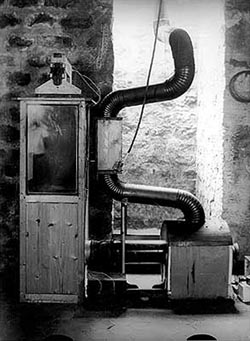 Étienne-Jules Marey, Smoke Machine No.2 1901
In 1901, financial support from the United States allowed the construction of a machine with 58 smoke trails, compared with only 20 in the 1899 machine. An electrical oscillating device forming a chronograph was also added to the second design. A camera was placed in front of a box closed by a transparent glass sheet, through which the smoke trails passed in front of a black velvet background. A magnesium flash at the right-hand side of the box provided illumination while instantaneous images were taken of the smoke trails, which Marey noted became very clear in the light of the magnesium flame.
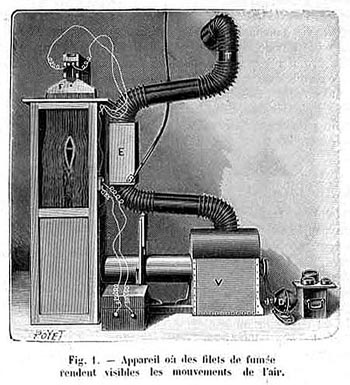 Étienne-Jules Marey, Smoke Machine No.2 1901 La Nature, Sept. 7, 1901
The smoke was produced by a burner fuelled with wood shavings and cotton waste, and passed through a series of small lead emission tubes spaced equally across the top of the transparent box. An electric fan at the base of the box drew the smoke trails down vertically from the top of the box, very thin and parallel,
"like the strings of a lyre". "When the fan is switched on, one sees all the threads of smoke fall through the casing to create a white sheet with longitudinal stripes; these threads then assume the appearance of stretched strings like those of a piano."  Étienne-Jules Marey, Smoke Trail
The smoke trails remained distinct for a distance of 20-30cm, then gradually began to merge with the surrounding air. A series of tubes, with cloth filters, removed the smoke and the cloud of powdered magnesium released by the flash. Once the arrangement of fine smoke trails had been achieved, an obstacle could be placed in the middle of them - a thin sheet of mica of infinitely variable shape and dimensions, or a body with a rounded end. The speed of flow could be increased or decreased using a control attached to the fan.
 Étienne-Jules Marey, Smoke Machine Trails Download a 750pixel image
The room where this strange machine was set up, either at the Station Physiologique or the Institut Marey, was plunged into semi-darkness. As the magnesium flash exploded, a camera set up in front of the glass would capture the smoke trails in "the capricious wanderings which they describe in the places where eddies form." "An important question for aviation is to know how the currents of air behave against three neighbouring and parallel planes, inclined at a given angle." One of Marey's photographs allowed an effective answer to that question.
"The problem is an important one. At a time when aerial locomotion is occupying so many researchers, there is a clear need to understand the behaviour of the air through which are passed bodies of various shapes: balloons, aeroplanes, etc. Even the flight of a bird, if the nature of the wing movements is shown by chronophotography, requires, in order to be understood, that one knows the behaviour of the air which gives the wing its support."Having studied the movement of humans, animals, and inanimate objects, including the infinitely small, clouds, wind and water, where might Marey turn his keen observation next? But it was now 1902 and, exhausted by illness, Marey was writing less. "Now I want to watch the others work," he observed. He died in 1904. Further Reading
Les mouvements de l'air étudiés par la chronophotographie These files can be de-compressed with the program Stuffit Expander which is available as a free download for both Mac and PC here
Étienne-Jules Marey (1830-1904): Inventor of first movie camera Étienne-Jules Marey was born on March 5, 1830 at Beaune, in the wine-producing district of France. On the advice of his father, a wine merchant, Marey went to Paris to study medicine. He combined a knowledge of medicine with a love of mechanics. This combination proved fruitful, for he invented, a number of scientific devices for recording, physiological movements in animals and human beings otherwise invisible to the eye.
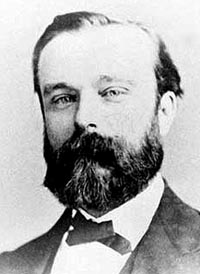 Étienne-Jules Marey, 1850
His first measuring machine named the 'Sphygmograph' counted human pulse beats and recorded them on a revolving smoked glass disc. He thus showed that attention to mechanical detail could produce accurate physiological measurements like pulse beats. The next instrument 'Kymograph' that he developed was for the transmission of animal movements from their site of origin. He devised a small capsule covered with a rubber membrane, from which a small rubber pipe transmitted variations in air measure to the moving needle on the paper recorder of the kymograph. With this ingenious machine, he measured the wing movements of bees and pigeons, and the leg movements of horses and men. Marey heard of the work of Eadweard Muybridge an English professional photographer: so he invited the latter in 1881 to give a demonstration to the scientists at Paris. Marey immediately saw, from Muybridge's results, the ideal, inertialess transmission and recording technique in photography. Using a rotating photographic glass plate, he introduced his 'photographic gun' which took twelve consecutive pictures per second.
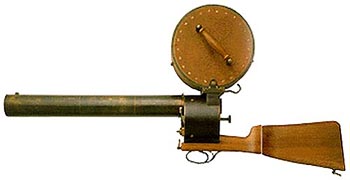 Étienne-Jules Marey, Fusil Photographique
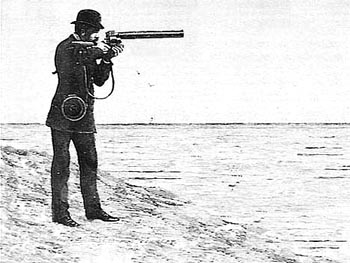 Étienne-Jules Marey, Fusil Photographique
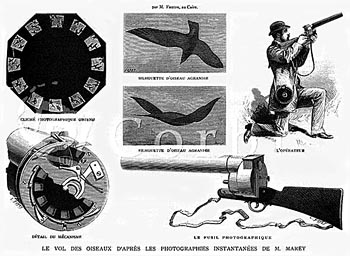 Étienne-Jules Marey, Fusil Photographique Download a 750pixel image
 Étienne-Jules Marey, Plate, Fusil Photographique
 Étienne-Jules Marey, Plate (enhanced view), Fusil Photographique
The images, the size of a postage stamp, were arranged round the edge of a revolving circular photographic plate, which was a development of the technique used a decade earlier by the astronomer Pierre-César Jules Janssen to capture the movement of stars. Janssen's apparatus made only 48 images in 72 seconds or 1.5 sec for each image and could hardly produce the illusion of movement. It was the advent of the dry photographic plate in 1880 which made possible Marey's shorter exposures.
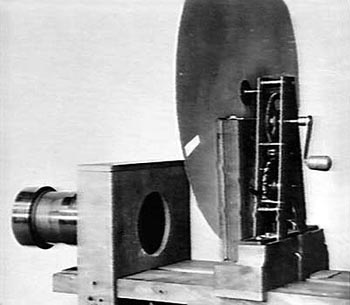 Étienne-Jules Marey, Rotating Disk Camera, 1883
The above camera consists of a rotating disk shutter and a circular plate that turns uniformly. The construction of this camera is suggested by the astronomer Pierre-César Jules Janssen. Only one image remains and is of Janssen with his head wrapped in a turban, smoking a cigarette on January 1, 1884. Even with the short exposure time given by the rotating disk, the images lacked clarity. According to Marey only pictures taken at long intervals would be successful with this camera. The next innovation which enabled accurate scientific study of movement was his final solution and led to the first modern movie camera. It employed a silver bromide emulsion on a paper ribbon, which was brought intermittently to rest behind a lens and obscured by a rotating shutter while moving forward for the next exposure.With the gelatin-based film that George Eastman introduced in 1885, Marey obtained 60 images per second each 9 cm x 9 cm. These were truly the first modern cinematography films.
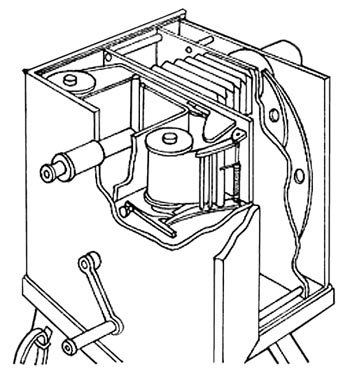 Étienne-Jules Marey, Chronophotographe à pellicule mobile, 1890
With the above camera, Marey not only recorded a wide variety of animal and human movements but laid the foundations for all subsequent cinematography. He used high speed technique to slow down rapid movements and invented the reverse-technique, time- lapse, to speed up slow movements. Marey acknowledged that his innovations were the practical extension of the inventions of Janssen (1824-1907) and Muybridge (1830-1904) to meet the split-second accuracy which they sought. For more about Marey's Cameras see Chronophotographical Projections by Charl Lucassen
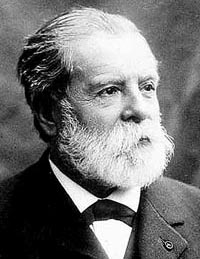 Étienne-Jules Marey, 1890
Marey published his results freely and served in the College de France as a Professor of Medicine from 1870 until his death (May 15, 1904). In 1898 the "Institut Marey'' was founded in Paris with assistance from the French Government, the city of Paris and the Royal Society, London. His colleagues and students continued his work for many years.
Étienne-Jules Marey Étienne-Jules Marey (b. 5 March 1830; d. 15 May 1904) started his career as an assistant surgeon in 1855, and specialised in human and animal physiology. In 1867 he became Professor of Natural History. He was the inventor of the "chronophotograph" (1888) from which modern cinematography was developed. Some in fact see Marey, rather than the Lumière brothers, as the true father of cine photography, though Marey's equipment had no transparent film, no perforation of film stock, and no claw to move the film along. Whereas others had used a number of cameras to study movement (Muybridge), Marey used only one, and the movements being recorded on one photographic plate. then from The Electric Library which says in part... Marey's greatest achievement was his use of photography to study movement. His chronophotographs (multiple exposures on single glass plates and on strips of film that passed automatically through a camera of his own design) had an important influence on both science and the arts and helped lay the foundation of motion pictures.
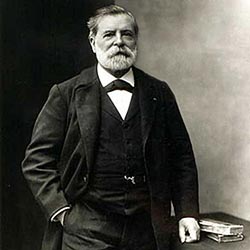 Étienne-Jules Marey by Nadar
Marey was born on Mar. 5, 1830, in Beaune, France. He studied medicine in Paris and became a member of the Academy of Medicine and the Academy of Sciences, of which he was made president in 1895. He held the chair of "Natural History of Organized Bodies" at the College de France from 1868 and published more than 150 scientific papers. For many years he was president of the French Photographic Society. In the early 1880's Marey published pictures of birds in flight made with his "photographic gun". A forerunner of the motion picture camera, it had a sight and a clock mechanism and made 12 exposures of 1/72th of a second each. Marey's observations concerning the changes in the shape of birds' wings in relation to air resistance was vital in understanding the phenomenon of flight.
Progress in Aviation Victor Tatin and Étienne-Jules Marey We next come to a series of very careful experiments, tried by an able mechanician, which almost demonstrate that artificial flight is accessible to man, with motors that have been developed within the last two years. These experiments were carried on by M. V. Tatin, who was then Professor Marey's mechanical assistant. He first began with beating wings, and produced, in 1876, the artificial bird which has already been briefly noticed under the head of "Wings and Parachutes."
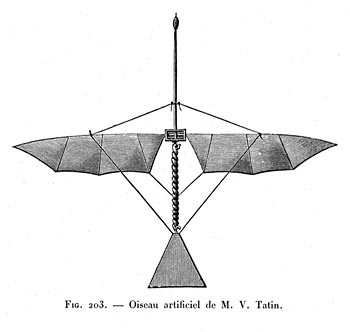 Victor Tatin Ornithopter of 1874 Download a 1000pixel image
This was driven by twisted rubber; not only did M. Tatin find that the power required was unduly great, but he also found that this power could not be accurately measured, the torsion of indict-rubber being erratic and stretching unequally. He constructed a large number of mechanical birds of all sizes and various weights; he tried many modifications and entire or partial reconstructions, and finally concluded, after spending a good deal of time and money, to take up the aeroplane type, to be driven by a reservoir of compressed air. With this his efforts were successful almost from the first, and he produced in 1879 the apparatus shown in fig. 58, which is practically the first that has risen into the air by a preliminary run over the ground. This machine consisted in a silk aeroplane, measuring 7.53 sq. ft. in surface, being 6.23 ft. across and 1.31 ft. wide, mounted in two halves at a very slight diedral angle, on top of a steel tube with conical ends which contained the compressed air. This reservoir was 4 3/4 in. in diameter and 33 1/2 in. long, was tested to a pressure of 20 atmospheres, and worked generally at 7 atmospheres; its weight was only 1.54 lbs., and its cubical capacity 0.28 cub. ft. From this (the vital feature of the machine) the stored energy was utilized by a small engine, with oscillating cylinder, placed on a thin board on top of the tube, and connected by shafts and gearing to two propellers with four vanes each, located at the front of the aeroplane. These propellers were 1.31 ft. in diameter, and rotated in opposite directions some 25 turns per second, their velocity at the outer end being about 100 ft. per second. The vanes were of thin bent horn set at a pitch of about 1.50 ft., and they towed the apparatus forward instead of pushing it. A tail of silk fabric 1.97 ft. across at the rear, by a length of 1.97 ft., was set at a slight upward angle and braced by wire stays, in order to provide for the longitudinal stability upon the principle advanced by Pénaud and the whole apparatus was placed on a light running gear consisting first of four wheels, and subsequently of three wheels. The total weight was 3.85 lbs., so that the sustaining surface of the aeroplane (omitting the tail) was at the rate of 1.95 sq. ft. to the pound.
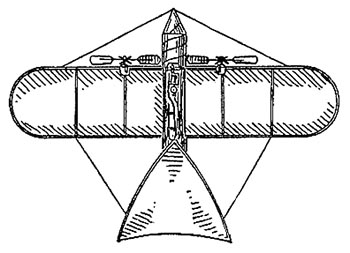 fig. 58, Victor Tatin Model, 1879
After a vast deal of preliminary testing and adjustment, the apparatus was taken to the French military establishment at Chalais-Meudon, where it was experimented with in 1879 upon a round board platform 46 it. in diameter. Upon this the machine would be set upon its wheels, the front and rear ends being fastened to two light cords carried to a ring around a central stake, and the compressed air would be turned on to the engine. The propellers would put the apparatus in motion and it would run from 65 to 165 ft. over the boards, until it attained a velocity of 18 miles per hour, when it would rise into the air, still confined radially by the two cords, and make a flight of about 50 ft., when, the power being exhausted, it would fall to the ground, almost invariably injuring the running gear in doing so. The flights were not very high, but on one occasion the apparatus passed over the head of a spectator. The angle of incidence was 70 or 8 o, and the power developed by the engine was at the rate of 72 33 foot-pounds per second, gross; but as its efficiency was only 25 to 30 per cent, of the gross power, the effective force was at the rate of 18.08 to 21.70 foot-pounds per second, or, say, at the rate of 5 footpounds per second (300 foot-pounds per minute) per pound of apparatus. This power was measured with great care, the machine being provided with a tiny gauge and tested repeatedly with a dynamometer. M. Tatin calls attention to the fact that the minuteness of the engine greatly diminished its efficiency, and that with large machines it would be comparatively easy to obtain 85 per cent. of the gross power developed. He draws the conclusion that his apparatus demonstrates that 110 lbs. can be sustained and driven through the air by the exertion of 1 horse power--a most important conclusion, which will be further discussed hereafter. To return, however, to the experiments: they are described as follows by M. Tatin I will pass without description a series of preliminary experiments which led me to modify certain details, until all conditions were favorable. I then had the satisfaction of seeing the apparatus start at increasing speed, and in a few seconds the carriage barely touches the ground; then it leaves it entirely at a speed of about 18 miles per hour, which agrees closely with the calculations. It describes over the ground a curve similar to those described by small models gliding freely, and when it comes down after its orbit, the shock as so violent as to injure the running gear. This accident recurred upon each experiment carried out under the same conditions; the carriage was soon destroyed, and even the propellers were injured, although they could be repaired. l then tried another experiment, which I had already attempted several times without success, in consequence of inadequate preparation. The apparatus, the running gear being removed, was suspended by two grooved wheels running freely over an iron telegraph wire 260 ft. long, stretched as rigidly as practicable. When the speed became sufficient, the apparatus rose, and then one of the propellers struck the iron wire; the front grooved wheel overtook the machine, and the propeller was destroyed. These accidents caused no repining, for they demonstrated that in all cases the apparatus had completely overcome the force of gravity. In order to continue the experiments I built a new carriage and new propellers, hoping to make them strong enough to stand the shocks during a new set of experiments, from which to deduce accurately the work done. The new running gear had but three wheels, these being larger and lighter than the old. The propellers, on the other hand, were made heavier) but modified so as to rotate more easily. Their vanes were made of a thin sheet of horn bent hot to the proper curvature. The inner two-fifths from the hub consisted of steel wire, this portion of a propeller requiring much force for rotation, and giving out but small effect toward propulsion; but the diameter and the pitch were the same as formerly. I was, unfortunately, unable to make all the experiments I desired with this repaired apparatus. I intended to study the results with various angles of incidence in the planes and various pitch of the propellers; then to study the important question as to the best proportion between the sustaining surface and the diameter of the propellers; and lastly the speed of translation which will best utilize the force expended. I was nevertheless enabled to deduce the following figures from my experiments. These figures are not absolutely exact, but sufficiently so to serve as a guide to others who may wish to engage in similar work. Calling A the sustaining surface in square meters (without the tail), and V the speed of translation in meters per second, then we may say: Lift = 0. kg. .045 A V2. And the motor will need to develop effective work at the rate of 1.50 kilogrammeters per kilogramme of the weight (4.935 foot-pounds per second per pound), which corresponds to one horse power for each 110 lbs. weight of the apparatus. These experiments seem to demonstrate that there is no impossibility in the construction of large apparatus for aviation, and that perhaps even now such machines could be practically used in aerial navigation. Such practical experiments being necessarily very costly, I must, to my great regret, forego their undertaking, and I shall be satisfied if my own labors shall induce others to take up such an enterprise. The effective work done by this aeroplane having been accurately measured, it affords a good opportunity of testing the method of estimating resistances which has been proposed by the writer in estimating the work done by a pigeon. The weight of M. Tatin's apparatus was 3.85 lbs. Its aeroplane surface was 7.53 sq. ft., the angle of incidence was 8 o, and the speed was 18 miles per hour, at which the air pressure would be 1.62 lbs. per sq. ft. Hence we have, by the table of "lift and drift": Lift, 8 o = 7.53 X 1.62 X 0.27 = 3.29 lbs., which indicates that a small part of the weight was sustained by the tail. The hull resistances are stated by M. Tatin to have been almost equal to that of the plane. These hull resistances would consist of that of the tube, of 0.12. sq. ft. midsection, which, having conical ends and parallel sides, will have a coefficient of about one-third of that of its midsection. The resistance of the wheels and running gear will be slightly greater, but must be guessed at, as the wheels would continue to revolve through inertia and thus increase the resistance. The front edge of the aeroplane, which was of split reed and about one-eighth of an inch thick, was 6.23 ft. long; but as the back edge of the aeroplane and the side borders of the tail would also produce some air resistance, we may call the edge resistance as equal to 6 ft. in length, by a thickness of 0.01 ft., without any coefficient for roundness. We then have the following estimate of resistances: Resistance of Tatin Aeroplane
Drift 8 7.53 X 1.62 X 0.0381 = 0.4648 lbs. and - as the speed was 18 miles per hour, or 26.40 ft. per second, we have for the effective power required: Power = 0.7268 X 26.4 = 19 19 foot-pounds per second, which agrees very closely with the 18.08 to 21.70 foot pounds per second said to have been effectively developed, and is at the rate of 5 foot-pounds per pound of apparatus, or of 110 lbs. of weight per horse power.
Étienne-Jules Marey et le vol des oiseaux Etienne Jules Marey tient une place importante dans ce programme. Professeur au Collège de France 39 ans, il obtientt deux ans plus tard, une importante subvention et un grand terrain dans l'Ouest parisien, où il construit aussitôt un laboratoire d'étude du mouvement qui deviendra célèbre : la station physiologique du Parc des Princes. Marey, à partir de 1882, jette les bases d'un moyen exceptionnel d'investigation scientifique, qu'il appellera plus tard chronophotographie, laquelle, par la suite, deviendra le cinéma. Dès 1888, Etienne Jules Marey avait déjà chronophotographié et, de 1889 à 1892, filmé, au sens propre du terme, c'est-à-dire enregistré sur film, un ou plusieurs sujets quasiment dans chacune des disciplines que le cinéma scientifique explorera plus tard.
 Étienne-Jules Marey in his study
Lorsque Marey entreprend l'étude du vol des oiseaux et des insectes, il témoigne d'une préoccupation majeure : découvrir les grandes lois de la locomotion aérienne. Mais ces phases correspondent aussi à des orientations méthodologiques, dont la philosophie générale est de préférer à l'observation directe (l'auscultation médicale, par exemple, avec la vue, l'ouïe, le toucher) une observation outillée dans laquelle les instruments enregistreront eux-mêmes les mouvements, les phénomènes à observer.
Gallery
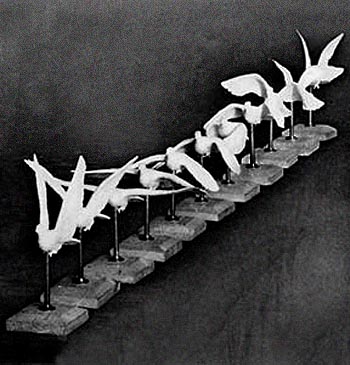 Étienne-Jules Marey, Sculptures of birds in flight
Drawings and sculptures of flying birds (1886-1890) http://www.expo-marey.com Using his chronophotographic cameras, first with glass plates and then with celluloid film, Marey succeeded in photographing the different phases of the flight of birds - seagulls, pigeons, herons and so on. The results, when compared with the graphs he had previously obtained, allowed Marey to publish a substantial volume entitled Le Vol des Oiseaux ("The Flight of Birds") in 1890. Alongside the plates and films, and with Georges Demenÿ's assistance, Marey once again produced sets of magnificent drawings. Better still, in 1887 he created a number of bronze and plaster sculptures which were truly kinetic works of art.
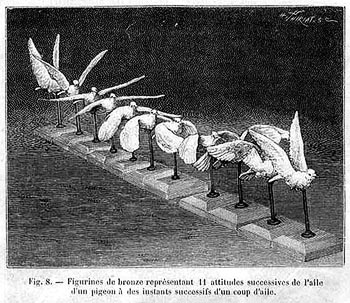 Étienne-Jules Marey, Sculptures of birds in flight La Nature, Dec. 5, 1887
His intellectual project therefore consisted of five successive steps: 1) Chronophotographic and/or graphical analysis of the flying bird; 2) A drawing or sketch based on this record; 3) Formation of sculptures to synthesise the analysed movement; 4) "Reanimation" of the sculptures by arranging them in a zoetrope; and 5) Scientific commentary by publication of books and papers.
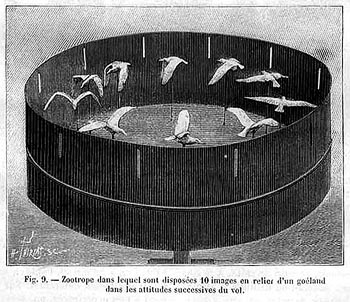 Étienne-Jules Marey, Sculptures of birds in flight mounted in a Miroscope, 1887 La Nature, Dec. 5, 1887
Miroscope : Viewer devised by Étienne-Jules Marey - a drum containing ten models of the motion of a flying bird in respective phases. A perfect illusion of the bird's flight is obtained by rotating the drum and observing these models through narrow slots located along the drum circumference. [The National Museum of Prague]
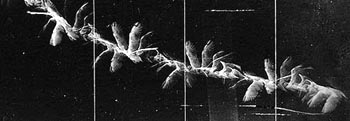 Étienne-Jules Marey, Bird Flight
 Étienne-Jules Marey, Bird Flight
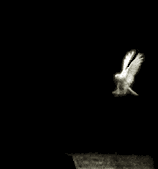 Étienne-Jules Marey, Bird Flight, Pigeon Landing, 1894 Animation by Charl Lucassen
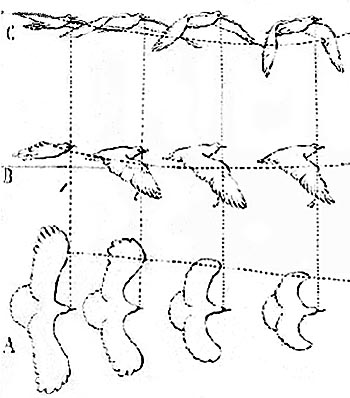 Étienne-Jules Marey. Drawing showing successive positions of a seagull during one complete wing revolution shown in vertical diagonal and horizontal views Marey, Étienne-Jules, "Mouvements de l'aile de oiseau repr&eactue;sent&eactue;s suivant les trois dimensions de l'espace" Comptus Rendus des S&eactue;ances de l'Acad&eactue;mie des Sciences, 7 February, 1887.
 Étienne-Jules Marey, 'Flight of gull', 1886 Braun, Marta. (1992) Picturing Time. The work of Etienne-Jules Marey (1830-1904). Chicago & London: The University of Chicago Press Flight of gull, 1886 - College de France Download a 1000pixel image
 Étienne-Jules Marey, 'Flight of gull', 1886 Braun, Marta. (1992) Picturing Time. The work of Etienne-Jules Marey (1830-1904). Chicago & London: The University of Chicago Press Flight of gull, 1886 - College de France Download a 1000pixel image
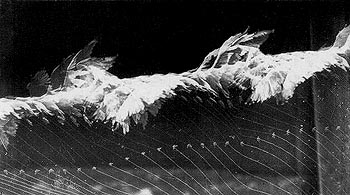 Étienne-Jules Marey, 'Flight of gull', 1886 Braun, Marta. (1992) Picturing Time. The work of Etienne-Jules Marey (1830-1904). Chicago & London: The University of Chicago Press Flight of gull, 1886 - College de France Download a 750pixel image
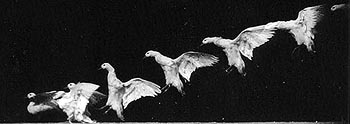 Étienne-Jules Marey, Bird Flight, Duck landing n.d.
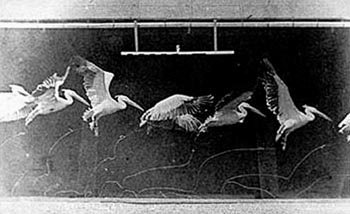 Étienne-Jules Marey, Bird Flight, Pelican, 1886
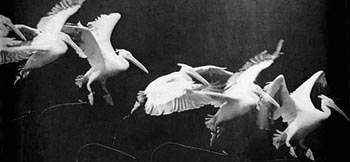 Étienne-Jules Marey, Bird Flight, Pelican, 1886
Further Reading
Le mécanisme du vol des oiseaux éclairé par la photochronographie
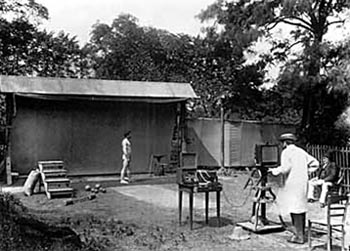 Étienne-Jules Marey, seated at right, in Albert Londe's outdoor chronophotographic studio
Londe and Marey were both close friends and working along similar lines (notice the similarity of their 'stages'). It is also worth noting though that Londe's cameras such as the one in the above photo and the contemporary illustration below, were of the 9-12-16? sequentially operated multi-shutter type rather than employing a single lens and rotating shutter. Eadweard Muybridge took it one step further employing up to 16 separate cameras each with a single plate and a shutter.
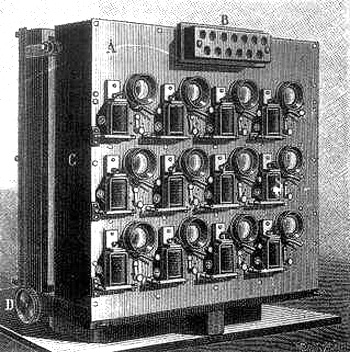 Étienne-Jules Marey - Albert Londe's twelve lens camera, 1893 Braun, Marta. (1992) Picturing Time. The work of Etienne-Jules Marey (1830-1904). Chicago & London: The University of Chicago Press Albert Londe's twelve lens camera, 1893. La Nature, November 1893 Londe went on to specialise in the use of chronophotography in the study of mental ilness at La Salpêtrière which was equipped with a clinical photographic laboratory and where Londe was attached to the neurological department. In 1893 he published the first book on medical photography. For more about Londe's chronophotographic work see Chronophotographical Projections by Charl Lucassen
The Station Physiologique As a physician and researcher, Marey always needed a laboratory in which to carry out his experiments, construct his apparatus, and house the subjects of his studies: insects, frogs and other living animals. During the 1860s he set up a number of laboratories which were true "cabinets of curiosities," which he would show off to his friends and pupils. The first of these laboratories, installed in a theatre on the Rue de l'Ancienne Comédie, Paris, made an indelible impression on the photographer Nadar.
 Station Physiologique, 1887
Marey created the Station Physiologique to effect his work in chronophotographic motion studies. Notice the 'stage' grander than but not dissimilar to similar to that of Londe's 'garden' studio. The following image from La Nature Sept. 8, 1883 better shows the setup including the 'mobile' camera, and the circular track.
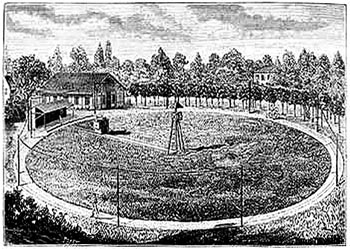 Track of the Station Physiologique, 1883 La Nature Sept. 8, 1883
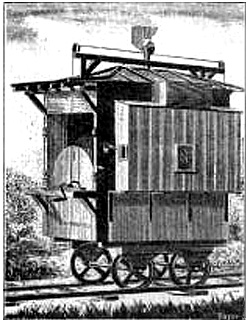 'Mobile' camera at the Station Physiologique, c.1883 probably La Nature Sept. 8, 1883 Braun, Marta. (1992) Picturing Time. The work of Etienne-Jules Marey (1830-1904). Chicago & London: The University of Chicago Press
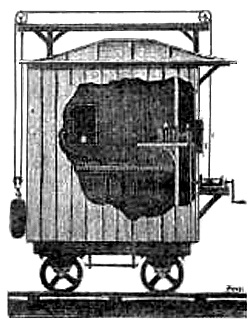 'Mobile' camera at the Station Physiologique, c.1883 probably La Nature Sept. 8, 1883 Braun, Marta. (1992) Picturing Time. The work of Etienne-Jules Marey (1830-1904). Chicago & London: The University of Chicago Press
Marey dreamed of a place which was better suited to his work, like the facilities which the English researcher Eadweard Muybridge enjoyed at Palo Alto, California. The situation was resolved thanks to the high-level connections of Georges Demenÿ, Marey's new demonstrator and assistant, and some funding from the Ministry of War. The stated purpose was to study ways of reducing the effort of troops, men, and animals, in time of war. A site was allocated to Marey close to the Bois de Boulogne, on the western edge of Paris, and he began construction of his Station Physiologique ("Physiological Research Station"). Work proceeded under the direction of an architect named Ziegler and under Demenÿ's watchful eye. However the funding was far from sufficient, and it took the intervention of Jules Ferry, excited by the results so far obtained by the researchers at the Station, to convince the Chambre des Députés (French Parliament) to vote through a supplementary budget for Marey and his collaborators.
 Étienne-Jules Marey, motion study, Station Physiologique
One of Marey's human motion sequences that more acurately shows the 'stage', the markers and the accuracy of image obtained using controllable human subjects rather then the somewhat random flight of his bird subjects. By 1882 the Station Physiologique was complete and Marey had no further cause to envy Muybridge's Palo Alto facilities. At last he had a great physiological and photographic laboratory. His interest in photography was growing: a dark background was installed to allow chronophotography of humans and animals, and the photographic rifle and fixed-plate Chronophotographe were invented in 1882. But Marey remained equally committed to his graphical methods and equipment. From now on the men and horses could move round two large circular tracks, and the apparatus no longer had to be carried from the location of one experiment to the next. The laboratory was set up in a small "chalet" building where Marey and Demenÿ produced photographs and diagrams drawn from their experiments. Much later, after his quarrel with Demenÿ, Marey endeavoured to bring this historic place - which had seen the birth of cinema, the theories of physical education, and aviation - to life. To preserve the memory of these discoveries, in 1899 he constructed the Institut Marey ("Marey Institute") on the same site, as a museum and laboratory gathering the results of his long years of research. After Marey's death, his students continued to use the research laboratory. Unfortunately they could do nothing to prevent its eventual demolition to allow the enlargement of the Roland Garros stadium. The end for the two laboratories which Marey had conceived and realised came in 1979, as the bulldozers swept everything away.
Further Reading
 Étienne-Jules Marey, Bird Flight, article Download a 1000pixel image
Picturing Time : THE book on Étienne-Jules Marey Étienne-Jules Marey was an inventor whose methods of recording movement revolutionized our way of visualizing time and motion. Best remembered for his chronophotography, Marey constructed a single-camera system that led the way to cinematography. Picturing Time, the first complete survey of Marey's work, investigates the far reaching effects of Marey's inventions on stream-of-consciousness literature, psychoanalysis, Bergsonian philosophy, and the art of cubists and futurists. Braun offers a fascinating look at how Marey's chronophotography was used to express the profound transformation in understanding and experiencing time that occurred in the late nineteenth century. Featuring 335 illustrations, Picturing Time includes many unpublished examples of Marey's chronophotographs and cinematic work. It also contains a complete bibliography of his writings and the first catalog of his films, photographic prints, and recently discovered negatives.
Chronophotographical Projections : Étienne-Jules Marey
'Étienne-Jules Marey: Movement in light' La Maison du Cinema and the Cinémathèque française designed and created the exhibition Étienne-Jules Marey: Movement in light from January 13 until March 19, 2000 in Paris. Together with the exhibition a website was launched on www.expo-marey.com . The site consists of an in depth description, several unique images and 63 Quicktime movies of his films. English listing of the Quicktime movies of Marey's films. Click on 'films' on the new page to go to that list.
'Étienne-Jules Marey: Movement in light' ; Media Collection
|
© Copyright 1999-2002 CTIE - All Rights Reserved - Caution |
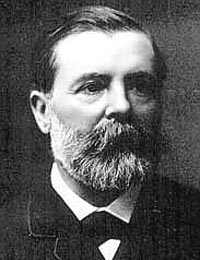 Étienne-Jules Marey : Movement in Light : Aviation
Étienne-Jules Marey : Movement in Light : Aviation